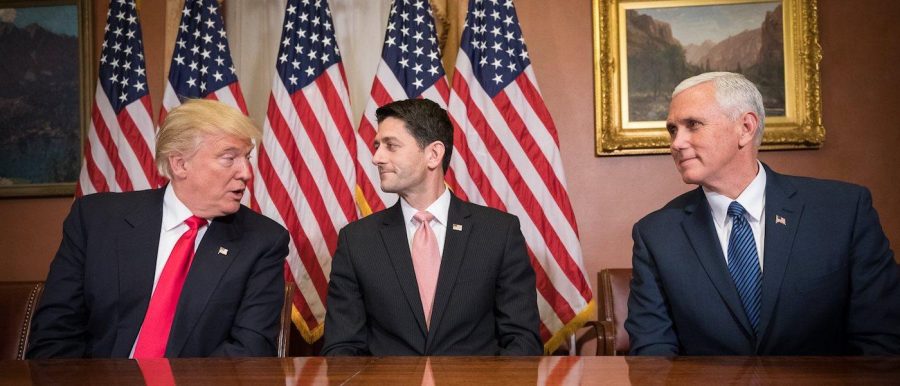On Friday, Jan. 20, 2017, Donald Trump was sworn into office as the 45th President of the United States.
A few hours after his inauguration, he signed his first six-part executive order which pledged that his administration will work to repeal Barack Obama’s Patient Protection and Affordable Care Act. Section two stated that the Secretary of Health and Human Services and the heads of all other executive agencies and departments will “waive, defer, grant exemptions from or delay the implementation of any provision or requirement of the Act that would impose a fiscal burden.”
SATURDAY – Jan. 21
Trump and Vice President Mike Pence spoke at the CIA headquarters in the afternoon. “There is nobody that feels stronger about the intelligence community and the CIA than Donald Trump,” Trump said. In his speech, Trump stressed eradicating radical Islamic terrorism and discussed his appointments to the cabinet.
SUNDAY – Jan. 22
On a phone call with Prime Minister Benjamin Netanyahu of Israel, Trump discussed ways to strengthen the relations between the United States and Israel. Both heads agreed to continue to work closely on a range of issues in the future such as Iran. Trump invited the prime minister to the White House in early February.
MONDAY – Jan. 23
Trump announced that he intends to nominate the President of the South Dakota School of Mines & Technology and former United States Congresswoman Heather Wilson to Secretary of the Air Force.
Trump signed several presidential memoranda. The first memorandum was to permanently withdraw the United States from the Trans-Pacific Partnership because he believes that the TPP Agreement is not in the best interest of American workers. His second memorandum imposes a hiring freeze on the executive branch to stop the expansion of the federal workforce and costs associated with this expansion. The last memorandum reestablishes the Mexico City Policy which ends funding from the United States to fund abortions overseas.
TUESDAY – Jan. 24
Trump signed a four-part executive order “expediting environmental reviews and approvals for high priority infrastructure projects.” Its purpose is to make the United States more competitive, increase wages for American workers, create jobs and reduce the costs of goods and services for American families and consumers.
Additionally, Trump released another presidential memorandum requesting for approvals to construct and operate the Dakota Access Pipeline which “represents a substantial, multi-billion-dollar private investment in [the] Nation’s energy infrastructure” and will serve the national interest.
Later, Trump signed another memorandum that invited TransCanada Keystone Pipeline, L.P., to re-submit its application for a Presidential permit for the construction and operation of the Keystone XL Pipeline which imports petroleum from Canada to the United States.
His third presidential memorandum of the day discussed developing a plan to have all new pipelines in the United States constructed from materials produced in the United States.
In a call with Prime Minister Narendra Modi of India, Trump emphasized India as a partner in confronting challenges around the world, and they discussed security in the South and Central Asia, as well as areas to strengthen their partnership such as the economy and defense.
WEDNESDAY – Jan. 25
On Wednesday, Trump signed two executive orders: one to enhance the public safety in the interior of the United States and another for border security and immigration enforcement improvements.
The first eighteen-part executive order discussed the removal of illegal immigrants and immigrants who have sanctuary, as well as employing all lawful means to enforce the United States’ immigration laws. To do this, this executive order stated that the Secretary of Homeland Security will hire 10,000 additional immigration officers.
The purpose of the second executive order with seventeen sections is to secure the United States’ border with Mexico, where there has been a recent surge of illegal immigration according to the executive order, and prevent further illegal immigration into the United States. For this to work, Trump wants the construction of a physical wall on the border with Mexico and to detain those apprehended on suspicion of violating either State or Federal law among other actions.
On this day, Trump announced that he intends to nominate former Military Intelligence officer Philip Bilden as the Secretary of the Navy. Recently, Bilden retired as the co-founding member and Senior Advisor of HarbourVest Partners, a private equity investment management firm.
Later, Trump approved disaster declarations in Oregon, Georgia and Mississippi, areas affected by severe storms, flooding, tornadoes or straight-line winds in January.
THURSDAY – Jan. 26
Trump spoke at the Congressional Republican National Committee Retreat in Philadelphia with Pence, Senate Majority Leader Mitch McConnell and Speaker of the House Paul Ryan.
FRIDAY – Jan. 27
Trump announced that he will launch a Manufacturing Jobs Initiative and meet with successful business leaders, such as those from The Dow Chemical Company, Dell Technologies, General Electric, Tesla and Under Armour among others, in order to gain their insights.
During the morning, Trump spoke with Mexican President Enrique Peña Nieto about United States’ current trade deficit with Mexico and working together to stop illegal guns and arms sales, drug trafficking and drug cartels.
Trump then met with Prime Minister of the United Kingdom Theresa May at the White House. “Madam Prime Minister, we look forward to working closely with you as we strengthen our mutual ties in commerce, business and foreign affairs,” Trump said. “Great days lie ahead for our two peoples and our two countries.”
Trump signed his fifth executive order on ethics commitments by executive branch appointees, which created an ethics pledge that must be signed by every appointee in every executive agency appointed on or after Jan. 20, 2017.
His most recent and signed executive order discusses “protecting the nation from foreign terrorist entry into the United States.” This order suspends the U.S. Refugee Admissions Program, which offers resettlement opportunities to those overseas who are of special humanitarian concern, for 120 days and the entry of people from Iraq, Iran, Libya, Somalia, Sudan and Yemen into the United States for 90 days and from Syria indefinitely.
SATURDAY – Jan. 28
Trump released his presidential memorandum for a plan to defeat the Islamic State of Iraq and Syria, including how to cut off ISIS’s financial support. In another memorandum, Trump reorganized the National Security Council, an action that every president usually takes.
– Maria Harrison – Asst. Features Editor –














